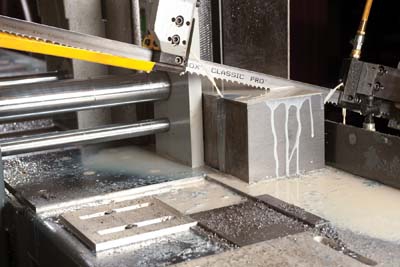
LENOX announces the introduction of the LENOX Classic Pro Band Saw Blade. The new blade is designed for durability when cutting a wide range of metals, from low carbon steels to higher strength alloys.
The LENOX Classic Pro bi-metal band saw blade features a proprietary backing steel preparation to increase fatigue life and minimize band breakage. The M42 high-speed steel edge provides superior heat and wear resistance when cutting a variety of metals. The advanced design enables production cutting of solid and structural steels and delivers consistent performance. Classic Pro benefits from a unique tooth geometry and set pattern that improves tooth penetration on saws with limited feed force and minimizes noise and vibration.
"Many of our customers require a multipurpose blade that has the ability to cut an array of metals. They may need to cut 2-inch rounds of carbon steel in the morning and then shift to cutting 3-inch squares of an alloy steel in the afternoon. When the sawing operation requires the flexibility to cut different sizes, shapes, and types of metal, the Classic Pro band saw blade provides performance and value," stated Matthew Lacroix, sr. product manager, Band Saw Division, LENOX. "Classic Pro is versatile enough to cut a range of metals, while providing consistent performance cut after cut. Customers that need general purpose blades to perform at a high level will appreciate the lower cost per cut the blade provides."
Ideal for cutting carbon steels, alloys, stainless, and aluminum solids and structurals, the LENOX Classic Pro Band Saw Blade is available at distributors nationwide.
Contact Details
Related Glossary Terms
- alloys
alloys
Substances having metallic properties and being composed of two or more chemical elements of which at least one is a metal.
- backing
backing
1. Flexible portion of a bandsaw blade. 2. Support material behind the cutting edge of a tool. 3. Base material for coated abrasives.
- bandsaw blade ( band)
bandsaw blade ( band)
Endless band, normally with serrated teeth, that serves as the cutting tool for cutoff or contour band machines.
- carbon steels
carbon steels
Known as unalloyed steels and plain carbon steels. Contains, in addition to iron and carbon, manganese, phosphorus and sulfur. Characterized as low carbon, medium carbon, high carbon and free machining.
- fatigue
fatigue
Phenomenon leading to fracture under repeated or fluctuating stresses having a maximum value less than the tensile strength of the material. Fatigue fractures are progressive, beginning as minute cracks that grow under the action of the fluctuating stress.
- fatigue life
fatigue life
Number of cycles of stress that can be sustained prior to failure under a stated test condition.
- feed
feed
Rate of change of position of the tool as a whole, relative to the workpiece while cutting.
- sawing
sawing
Machining operation in which a powered machine, usually equipped with a blade having milled or ground teeth, is used to part material (cutoff) or give it a new shape (contour bandsawing, band machining). Four basic types of sawing operations are: hacksawing (power or manual operation in which the blade moves back and forth through the work, cutting on one of the strokes); cold or circular sawing (a rotating, circular, toothed blade parts the material much as a workshop table saw or radial-arm saw cuts wood); bandsawing (a flexible, toothed blade rides on wheels under tension and is guided through the work); and abrasive sawing (abrasive points attached to a fiber or metal backing part stock, could be considered a grinding operation).
- sawing machine ( saw)
sawing machine ( saw)
Machine designed to use a serrated-tooth blade to cut metal or other material. Comes in a wide variety of styles but takes one of four basic forms: hacksaw (a simple, rugged machine that uses a reciprocating motion to part metal or other material); cold or circular saw (powers a circular blade that cuts structural materials); bandsaw (runs an endless band; the two basic types are cutoff and contour band machines, which cut intricate contours and shapes); and abrasive cutoff saw (similar in appearance to the cold saw, but uses an abrasive disc that rotates at high speeds rather than a blade with serrated teeth).
- wear resistance
wear resistance
Ability of the tool to withstand stresses that cause it to wear during cutting; an attribute linked to alloy composition, base material, thermal conditions, type of tooling and operation and other variables.






